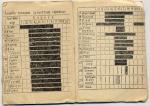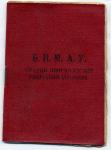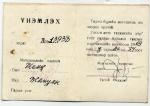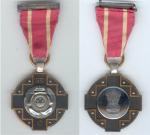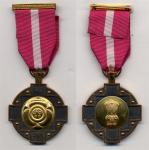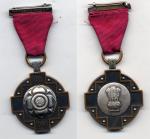-
Posts
14,343 -
Joined
-
Last visited
-
Days Won
25
Content Type
Profiles
Forums
Blogs
Gallery
Events
Store
Everything posted by Ed_Haynes
-
-
After several pages of regulations, some tables showing, apparently, the "open seasons" on various animals.
-
-
-
-
-
More of his documents just arrived. Certificate for free transportation on public transport (except taxis) issued by Mongolian Commission of Veterans, 30 November 1990.
-
Yes, Afghanistan (= South Asia, where these are discussed).
-

Virtual Medals?
Ed_Haynes replied to Lukasz Gaszewski's topic in Great Britain: Orders, Gallantry, Campaign Medals
Tha humanitarian medal is, apparently, still under discussion, though the new medal for "reconstruction" in Iraq seems to reduce some of its usefulness. Havn't heard much about the Irish medal, though I know it has been discussed, with the closing of the "Northern Ireland" clasp to the GSM. -
If someone with the power can move this to the "other foreign", it might get answered, as China is NOT Southeast Asia.
-

Soviet Berlin, May 1945 picture
Ed_Haynes replied to Bryan's topic in Russia: Soviet Orders, Medals & Decorations
But Lord Ashcan holds a title of nobility -- "Baron Ashcroft of Chichester" [not ". . . of Belize" as he wanted]-- for his "political services" to the conservatives. Of course he does not use "Sir" because he is a lord. But Zhukov had two Orders of Victory, but no Victoria Crosses, in his collection. Lord Ashcan has all the VCs. -

Soviet Berlin, May 1945 picture
Ed_Haynes replied to Bryan's topic in Russia: Soviet Orders, Medals & Decorations
Quite sure. Only the UK and some places like Bermuda still send up recommendations for "Imperial Honours". Canada, Australia, etc. haven't done so for some time now and have their own systems. Likewise, they have dropped the whole "knighthood" business, leaving only the UK holding onto those customs. -
1- These "category A" awards and their documents are discussed in detail over in another thread. 2- I'd worry A LOT about a certificate with the name obliterated with "White-Out" and a new (fraudulent?) name typed in!
-

Soviet Berlin, May 1945 picture
Ed_Haynes replied to Bryan's topic in Russia: Soviet Orders, Medals & Decorations
No, British ("Imperial") honours are no longer given in Canada. -

Soviet Motherhood Medals
Ed_Haynes replied to a topic in Russia: Soviet Orders, Medals & Decorations
Good point, Jim. Thanks for the reminder. -

Soviet Motherhood Medals
Ed_Haynes replied to a topic in Russia: Soviet Orders, Medals & Decorations
I was taking the 'buy it now' price, but we're both in the same area -

Soviet Motherhood Medals
Ed_Haynes replied to a topic in Russia: Soviet Orders, Medals & Decorations
According to http://www.oanda.com/convert/classic "1,300 Russian Rouble = 48.93473 US Dollar" -

Mongolia Is this what I think it is?
Ed_Haynes replied to Ed_Haynes's topic in People's Republic Mongolia
Translation and guidance is being sought from An Expert. It does seem to make reference to a whopping 55 Tugriks. -
The strained inter-ministry and national politics surrounding this award and the events it represents are a big part of the story. The medal was never manufactured (beyond four specimens) but awards were made and the ribbon is worn. But even today, it would take a brave person to wear the ribbon in the Punjab (if anyone knew what it meant). Set aside the fact that it was an incredibly ugly medal with an impossible ribbon.
-
Reverse - Blank, presumably intended for naming. To quote from a forthcoming book As I said, only four specimens were ever made, and the medal was never awarded. But the ribbon is seen in ribbon bars. For example:
-
Padma Shri Awarded to recognize distinguished service to the nation. Established: Established in notification No.2-Pres./54 of 2 January 1954, by the President of India. The statutes were revised by No.4-Pres./55 of 8 January 1955 to alter the design remove the class structure and further amended by No.28-Pres./55 of 30 August 1955 (to make provision for a miniature badge of the award) and by No.9-Pres./57 of 26 January 1957 (when the award was further redesigned, as detailed below). Award of the decoration was suspended from 13 July 1977 to 26 January 1980. General Appearance: The medal a massive circular geometrical badge, 30 mm in diameter. Obverse: The badge specified in January 1955 was to be a ?mainly circular? 30-mm toned bronze badge with geometrical patterns and, in the center, a lotus flower with five major petals embossed in white gold. Above and below this flower, the name of the decoration ?Padma / Shri? was to be embossed in silver-gilt. In 1957, the badge itself was altered to be of burnished bronze, with all embossing in silver. Reverse: In the center, the national emblem, with motto below, in silver. Ribbon: 31 mm, medium pink (?lotus-colored?) with two 6 mm white stripes. Female recipients are authorized to wear the badge from a bow fashioned from this ribbon. Some sources suggest that the initial ribbon for the Padma Vibhushan, Tisra Varg, was to have been a light pink with three narrow white central stripes; ribbons in such design exist in some collections. Since 1981, a darker pink has been used for the Padma Shri ribbon and the ribbon has had corded edges. While no documentation for these ribbon alterations has been found, the shifts in ribbon colour are supported by observation of specimens. Suspension: The badge is suspended by a ring. Naming: The award is unnamed. Miniature: A miniature was provided for in 1957. Representative Citation: To understand the award better, a sample recipient would be the award of 26 January 1971 to Dr Harbhajan Singh, Head of the Plant Introduction Division, Indian Agricultural Research Institute, New Delhi. (No.8-Pres./71 of 26 January 1971): ?Dr. Harbhajan Singh (55) has conducted intensive research in Plant Breeding, Plant Genetics and Taxonomy and evolved a number of high yielding varieties of vegetables. He has arranged the systematic collection and dissemination of richly diverse germ plasm from exotic and indigenous sources for a wide variety of agri-horti-sylvi-cultural plants under phytosanitary conditions. Plant Breeders the world over, and those of India in particular have benefited from this activity. In the field of plant exploration he has carried out one-man trips and has also led teams of agricultural plant explorers, to different parts of India and neighbouring countries. This has helped in the collection of wide germ plasm comprising primitive and obsolete cultivation of many crop plants as well as of their wild relatives, which is a major contribution to the important task of stemming genetic erosion. ?He played a leading role in the breeding an d selection of nearly 40 varieties of field crops and vegetables several of which are of all-India importance. As Head of the Division of Plant Introduction, Indian Agricultural Research Institute, he has played an active part in the establishment and organisation of the National Plant Introduction Service. He has published 120 scientific, technical and popular articles including monographs, bulletins, research reviews and others relating to agri-horticultural plants.?
-
Padma Bhushan Awarded to recognize distinguished service to the nation of a high order. Established: Established in notification No.2-Pres./54 of 2 January 1954, by the President of India. The statutes were revised by No.3-Pres./55 of 8 January 1955 to alter the design and to remove the class structure and further amended by No.27-Pres./55 of 30 August 1955 (to make provision for a miniature badge of the award) and by No.8-Pres./57 of 26 January 1957 (when the award was further redesigned, as detailed below). Award of the decoration was suspended from 13 July 1977 to 26 January 1980. General Appearance: The medal a massive circular geometrical badge, 30 mm in diameter. Obverse: The badge specified in January 1955 was to be a ?mainly circular? 30-mm toned bronze badge with geometrical patterns and, in the center, a lotus flower with three major petals embossed in silver gilt. Above and below this flower, the name of the decoration ?Padma / Bhushan? was to be embossed in silver-gilt. In 1957, the badge itself was altered to be of burnished bronze, with all embossing in silver gilt. Reverse: In the center, the national emblem, with motto below, in silver gilt. Ribbon: 32 mm, medium pink (officially, ?lotus-colored?) with a 6 mm central white stripe. (Medium pink 13 mm, white 6 mm, medium pink 13 mm.) Female recipients are authorized to wear the badge from a bow fashioned from this ribbon. Some sources suggest that the initial ribbon for the Padma Vibhushan, Dusra Varg, was to have been a light pink with two narrow white central stripes; ribbons in such design exist in some collections. Since 1981, a darker pink has been used for the Padma Bhushan ribbon and the ribbon has had corded edges. While no documentation for these ribbon alterations has been found, the shifts in ribbon colour are supported by observation of specimens. All badges are awarded with a silver gilt floriated brooch bar. Suspension: The badge is suspended by a fixed, non-swiveling ring. Naming: The medal is unnamed. Miniature: A miniature with brooch bar was provided for in 1957. Representative Citation: To understand the award better, a sample recipient would be that awarded 26 January 1963 to Ramanlal Gokaldas Saraiya: "A pioneer in the field of cooperative Sri Ramanlal Gokaldas Saraiya has rendered valuable cooperation to develop the cooperative movement in India. He has been Chairman and Vice-Chairman of many State and All-India level organisations like Bombay State Cooperative Bank, All India Cooperative Organisation, National Development and Storage Board, etc. "Shri Saraiya is a member of many important Commerce Organisations of the country. In 1953-54 he was Chairman of the Federation of Indian Chamber of Commerce and Industry and a Director of Reserve Bank of India and Indian Insurance Corporation. "Shri Saraiya is Chairman of Maharashtra State Road Transport Corporation since 1954. Under his skillful supervision the Corporation has made a big progress and now it is thought that among the Public Sector Undertakings its management is the best." He had also been awarded the OBE in 1941.
-
Padma Vibhushan Awarded to recognize exceptional and distinguished service to the nation. Established: Established by notification No.2-Pres./54 of 2 January 1954, by the President of India. The statutes were revised by No.2-Pres./55 of 8 January 1955 to redesign the badge and remove the class structure and further amended by No.26-Pres./55 of 30 August 1955 (to make provision for a miniature badge of the award) and No.7-Pres./57 of 26 January 1957 (when the award was further redesigned, as detailed below). Award of the decoration was suspended from 13 July 1977 to 26 January 1980 (No.65-Pres./77 and No.25-Pres./80). General Appearance: The medal a massive circular geometrical badge, 30 mm in diameter. Obverse: The badge specified in January 1955 was to be a ?mainly circular? 30-mm toned bronze badge with geometrical patterns and, in the center, a lotus flower with four major petals embossed in white gold. Above and below this flower, the name of the decoration ?Padma / Vibhushan? was to be embossed in silver-gilt. In 1957, the badge itself was altered to be of burnished bronze, with all embossing in white gold. Reverse: In the center, the national emblem with motto below, in white gold. Ribbon: 32 mm, lotus pink. Female recipients are authorized to wear the badge from a bow fashioned from this ribbon. Some sources suggest that the initial ribbon for the Padma Vibhushan, Pahela Varg, was to have been a light pink with a single narrow white central stripe; ribbons in such design exist in some collections. Since 1981, a darker pink has been used for the Padma Vibhushan ribbon and the ribbon has had corded edges. While no documentation for these ribbon alterations has been found, the shifts in ribbon colour are supported by observation of specimens. All badges are awarded with a silver floriated brooch bar. Suspension: The badge is suspended by a fixed, non-swiveling ring. Naming: There is no naming. Miniature: A miniature with brooch bar was provided for in 1957. Representative Citation: To understand the award better, a sample recipient would be that to the Air Chief Marshal Om Prakash Mehra, Indian Air Force, awarded 26 January 1977: ?Former Chief of the Air Staff, Air Chief Marshal Om Prakash Mehra, served the Indian Air Force with distinction. Born on 19-1-1919, he joined the IAFVR on 30th November 1940 as a Commissioned Officer. He served in the North West Frontier and in Burma-Arakan Coast with No. 3 Squadron. In 1946 he served as representative of the Indian Air Force with the Indian defence contingent of the Joint Chiefs of Staff in Australia, an organization representing Britain, Australia, New Zealand and India which was responsible for the control of elements/formations of the defence services of these countries in Japan. ?In 1947 he took over command of the Flying Training School at Jodhpur. In the Air Force, he held various posts, including Director of Training, Senior Air Officer of Operational Group, Commander Armament Training Wing and Air Officer-in-Charge Policy and Plans at Air HQ. He served as Dean of the Institute of Armament Technology for 3 Years. He was appointed Deputy Chief of the Air Staff in 1969. In January 1971 he was selected as Chairman, Hindustan Aeronautics Limited, Bangalore. He took over as Chief of the Air Staff on 15th January, 1973 and relinquished the appointment on 31st January, 1976, on retirement. ?Air Chief Marshal Mehra was awarded the Param Vishisht Seva Medal in 1968. Being deeply interested in sports and physical education, he is currently the President of the National Indian Olympic Association and is a member of the Board of Governors of the Society for the National Institutes of Physical Education and Sports.?
-
Bet you haven't seen THIS! To personnel of the National Security Guards who took part in ?Operation Black Thunder? in the Punjab in 1988. We believe only four were ever made, and never issued. For obvious reasons?
-

Iraq Reconstruction Service Medal
Ed_Haynes replied to Ed_Haynes's topic in Great Britain: Orders, Gallantry, Campaign Medals
Well, it is a civilian medal. Intended for "reconstruction" services. The military have their medal already, with as many clasps as it needs?




